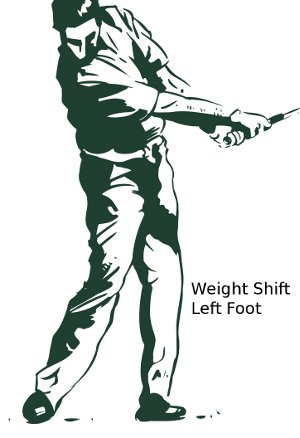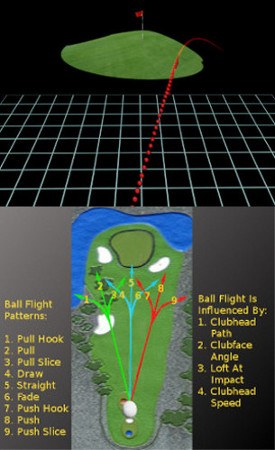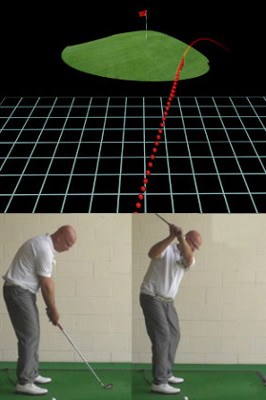
The slice is widely acknowledged to be golf's most common miss. But why? It has much to do with the awkward nature of the golf swing.
A slice – a shot that curves drastically to the right (for righties) -- happens when the clubface is open in relation to the swing path at impact with the ball, imparting left-to-right spin. The average golfer's swing creates this combination automatically through a series of incorrect motions.
Fact is, few if any golfers naturally swing the club on an inside-to-outside path which prevents slicing. That takes specific technique and considerable repetition. Lacking those essentials, most golfers are doomed to the outside-to-in path at the root of most slices.

Improper weight shift is frequently the culprit. The proper sequence finds the golfer's weight shifting to the right foot on the backswing, then to the left on the downswing and follow-through. This feels unnatural to many players, who “reverse pivot” (shift right to left going back, then left to right coming through) and suffer from slicing.
Another common flaw is to allow the upper body to control the swing, rather than leading with the hips and torso. This causes an “over-the-top” action, sending the clubhead outside the correct path on its way to the ball.
You don't need us to tell you that the slice is a common problem in the game of golf.

You've certainly seen plenty of players at your local course deal with the slice, and you've probably had to deal with it yourself from time to time. In fact, you may still be dealing with it currently, as this is a difficult problem to correct. The slice is so frustrating in large part due to its persistence – many players feel like no matter what they try to do with their swing, the slice just won't go away.
In this article, we are going to talk about why the slice is such a common problem for amateur golfers. We are going to look at the root cause of the slice, which will help you to understand why it is that so many golfers struggle to break this pattern. By gaining an understanding of the mechanics behind the slice, you can begin to get a handle on what it will take to straighten out your ball flight once and for all. It's not going to be easy, of course, but it is possible. Most golfers never take the time to learn why the slice occurs, and they stand virtually no chance of fixing it as a result.
While it might sound a little corny, the first thing you are going to need if you are going to fix your slice is a positive attitude. Too many golfers think negatively about this problem – or about other problems in their game – and they never manage to get on track as a result. It's okay to be frustrated, but you can't let that frustration get in the way of productive practice. Your slice isn't going to go away by accident. Rather, it is going to be eliminated only through hard work and clear thinking. By putting your mind in a good place, you will be far more likely to come out of this process with a successful result.
All of the content below is based on a right-handed golfer. If you happen to play left-handed, please take a moment to reverse the directions as necessary.
The Basics of a Slice

If you are confused each time you see your ball curve off to the right as it flies, this section is for you. We are going to break down the slice to the basics to make sure you have a clear understanding of this issue. Then, as we move on with the article, we will talk about why so many players fall victim to this problem, and what you can do to get yourself on track.
First, what is a slice? Is it any shot which misses to the right of the target? No. Is it any shot that curves to the right as it flies? Again, no. It is a very specific type of shot that fits into the category of a slice, and you need to understand what a slice looks like before going any farther. After all, it would be a mistake to attempt to fix a slice which doesn't actually exist in the first place.
For a basic definition, you can think of a slice as a shot which starts in the general direction of the target, only to quickly turn hard to the right in the air. The curve is not an intentional one, and it is not under control as it heads down the fairway. Rather, the ball is curving wildly to the right, and it usually strays far from the intended target line before it comes down. While the slice is most common off the tee, it is certainly possible to slice approach shots from the fairway, as well. Any shot, hit with any club, that curves out of control to the right can be considered a slice.
Right away, you can probably see where you may have been mistaken in the past, thinking a shot was a slice when it was actually something else. For instance, many golfers confuse a 'push' with a slice. A pushed golf shot is one which starts to the right of the intended target line and then flies mostly straight until it comes down. It is certainly possible for this kind of shot to end up as far off line as a slice, but that does not mean they are the same thing. The mistakes you make in your swing to wind up with a push are far different than the errors required to hit a slice, so it is important to discern between the two.
You also need to differentiate between a fade and a slice. While these two shots turn in the same direction, that is where the similarities end. Yes, a fade curves to the right, but only to a small degree, and it is an intentional ball flight pattern. Plenty of golfers – including many professionals – use a fade intentionally to move their ball toward the target. There is nothing at all wrong with using a fade, and it might even be your best option to build a consistent game. As you gain more and more experience in golf, you will come to discover whether a draw or a fade works better for you personally. There is no right or wrong here, as both options can be highly effective.
Still, you need to recognize that a fade is not a slice. A fade is a shot played with solid mechanics and a plan to turn to the ball from left to right. On the other hand, a slice is a shot which is out of control, not headed toward the target, and is usually the result of a faulty swing. Some golfers will try to pass their slice off as a fade, but it is pretty easy to tell the difference. If the shot is curving wildly to the right, and if it is struggling to stay anywhere near the target, it is almost certainly a slice.
At this point, you should be pretty clear as far as recognizing a slice when you see one. But what is it that causes the ball to turn so dramatically to the right in the first place? The following points should clear up any remaining confusion.
- It's all about spin. Safe to say, golf is a game that is all about spin. While you can't really see the spin on most of your shots as they fly – the ball is moving way too fast for that – you should know that it's there. The spin you impart on the ball at impact is going to have a profound effect on the way it travels toward the target. If you want to have control over your ball on the course, you need to learn how to control spin. In this case, a ball that is spinning rapidly from left to right is going to turn into a slice. That same left to right spin can produce a beautiful fade when less spin is put on the ball, but the shot will quickly get out of control as the spin rate skyrockets. While it is not simple to achieve, the goal here is quite easy to understand – reduce the amount of left to right spin placed on the ball, and you will reduce (or eliminate) your slice.
- The combination of swing path and face angle. The two main elements which determine how much side spin is going to be present on a given shot are swing path and face angle. Swing path is the direction that the club is moving as it makes contact with the ball. Face angle, as the name would indicate, is the direction that the face is pointing at impact. So, for example, if you were swinging directly toward the target, and the face was perfectly square with that target, you would hit a straight shot (this is extremely difficult to pull off in real life). Most of the time, you are not going to produce a swing that falls into the square/square category. When talking about the slice, we are talking about a face angle that is dramatically open in relation to the swing path. Commonly, that means the face hangs open while the swing comes across the ball from outside to inside. This is the classic slice pattern, and it is a hard one to correct. It should be noted that you don't actually need to swing across the ball in order to hit a slice, despite what you may have been told in the past. If you swing straight down the line through impact, you can still hit a slice if your club face is wide open. This is not as common, but it is possible.
- The swing is usually steep. It is not necessary to make a steep swing in order to produce a slice. However, most slicers do have a steep downswing, as this is a common sign of a swing which is coming from outside the proper path. If you swing down from outside-in, you will probably be swinging steeply down as well. That means you will be putting plenty of backspin on the ball, in addition to all of the side spin. What you are left with is a shot that balloons high up into the sky while slicing to the right. This is an ugly shot, and one that is rarely going to lead to good results.
We've covered a lot of ground in this section, but you should now have a pretty good understanding of the slice. As we move forward with the rest of this article, we'll talk about why the slice is so common, and what steps you can take to solve this problem.
It Comes Naturally

One of the big problems related to the slice is the fact that it comes naturally for so many golfers. When a new golfer gets started in this game, there is a good chance that he or she is going to swing the club in a manner that leads to a slice. For many, it just feels natural to swing the club this way. That is unfortunate, of course, because it means most golfers have to learn how to get away from this natural swing before they can put themselves in a position to be successful.
From the top of the backswing, it is natural for many golfers to use their hands to push the club down toward the ball. After all, this does make a lot of sense on the surface. The club is the instrument that is actually responsible for hitting the ball, so why wouldn't you send it down toward the ball as fast as you can? Of course, as any experienced golfer can tell you, this is not how the swing should work. When the hands lead the way from the top of the swing, the club will usually be pushed outside of the proper path, causing an outside-in hit at impact. That outside-in path, combined with an open face, will produce a slice.
Ideally, the lower body should lead the way, turning toward the target as the club hangs back. Once the lower body has moved through the shot, the club can follow along and rip through impact with plenty of power. When timed right, a swing that is led by the lower body is capable of sending the ball tremendous distances right down the middle of the fairway. Very few golfers get to start from a point where they are making this kind of swing. The majority of players start out with a swing that produces a slice, and they are forced to make adjustments to get into position. If you currently hitting a slice, you shouldn't feel ashamed that you find yourself at this point. Most golfers go through this at one point or another, especially if they are just getting started in golf. You can take solace in the fact that millions of other golfers have faced the same challenge, and many of them have come out on the other side with a slice-free game.






